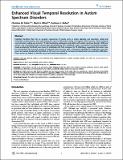Increased perceptual resolution: temporal event structure coding in autism spectrum disorders

View/
Date
2012-03-21Author
Elliott, Mark
Metadata
Show full item recordUsage
This item's downloads: 401 (view details)
Recommended Citation
Falter, C.M., Elliott, M.A., & Bailey, A. (2012) 'Increased perceptual resolution: temporal event structure coding in autism spectrum disorders'. Plos One, .
Published Version
Abstract
Cognitive functions that rely on accurate sequencing of events, such as action planning and execution, verbal and nonverbal communication, and social interaction rely on well-tuned coding of temporal event-structure. Visual temporal event-structure coding was tested in 17 high-functioning adolescents and adults with autism spectrum disorder (ASD) and mental- and chronological-age matched typically-developing (TD) individuals using a perceptual simultaneity paradigm. Visual simultaneity thresholds were lower in individuals with ASD compared to TD individuals, suggesting that autism may be characterised by increased parsing of temporal event-structure, with a decreased capability for integration over time. Lower perceptual simultaneity thresholds in ASD were also related to increased developmental communication difficulties. These results are linked to detail-focussed and local processing bias.

